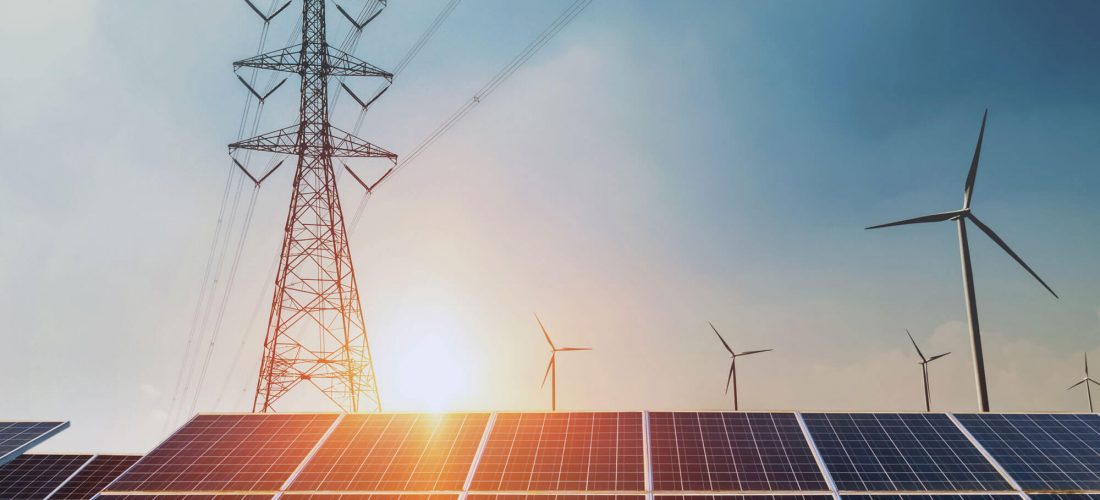
How can solar energy provide grid support?
- On April 29, 2021
How can solar power help support the grid? This is an increasingly pressing question in places such as Europe, where renewable energy is gradually moving to dominate the electricity network.
The European Union got 34% of its electricity from renewable sources in 2019, with Austria and Sweden seeing levels of more than 70%. Solar accounts for a growing proportion of the total. The continent added 18.2 GW of new solar capacity in 2020 alone.
Rising levels of solar energy on the grid are good news for Europe’s decarbonization plans, but a headache for grid operators.
In legacy grids, where energy is supplied by large thermal units such as coal or nuclear plants, the rotating masses of the turbines tend to provide continuous frequency and voltage regulation across the electricity network.
But intermittent renewable energy sources such as solar and wind can’t do this. Their output is dependent on weather conditions, and the output of a PV panel can flicker and wobble by the minute if there are clouds overhead. Or that was the situation until recently, at least.
Conscious of the need to do more than just deliver energy to the grid, solar energy technology developers have been increasing the level of control that plant owners have over output.
The result is that modern solar plants can now do a lot more than just pump out electricity whenever the sun is shining.
The impact of Commission Regulation 2016/631
The specifications for grid-connected assets in Europe are governed by a network code on requirements for grid connection (NC RfG) approved by the European Commission in 2016 and phased in up until April 2019.
The NC RfG imposes certain conditions on generation assets depending on their size, including for example the frequency range they are allowed to operate in, their response to over-frequency events, voltage parameters, and so on.
It acts as an overarching framework but allows national regulators to impose additional or more stringent requirements if needed.
This is what regulators have done in most European markets so that in practice the extent to which a solar farm might be required to provide grid support varies from one country to another.
Consequently, European solar asset owners with geographically diversified portfolios should expect to potentially use their assets for a range of grid support functions as well as simply selling energy.
This should not be a problem, since the provision of ancillary grid services such as frequency control can yield welcome additional revenue streams. However, it does mean solar asset owners need to include sophisticated power plant controllers (PPCs) and advanced inverters in their designs.
Furthermore, it is increasingly desirable to integrate battery storage systems with PV systems, so that solar plants can dispatch energy when needed and are not strictly tied to the availability of sunlight or influenced by the vagaries of the weather.
How can solar energy support the grid?
The most obvious way in which solar plants can support grid operators is by modulating plant output to closely match demand where possible. In situations where plant output exceeds demand, this can be achieved by curtailing production to match the demand curve.
A more elegant and controllable solution is to use DC-coupled energy storage to store overproduction for release to the grid when demand exceeds production.
Overproduction could happen, for example, where the output exceeds the power of the inverter (in which case the process of storing it is called clipping recapture) or where power is being curtailed (curtailment recapture).
Energy storage can also help smooth plant output at a more granular level, providing ramp-rate control so the grid does not have to cope with rapid fluctuations in production.

Source: Sungrow.
Increasingly, however, solar plants are being called upon to deliver more complex types of grid support, particularly providing active and reactive power for grid frequency and voltage control.
The use of reactive power for voltage control is particularly important because if this can be delivered at the PV plant connection then it can avoid the need for wasteful grid losses.
European grid operators frequently require reactive power to be delivered within a few hundred milliseconds of an overvoltage event. Active power, which is required to correct frequency fluctuations, can be delivered over slightly longer time periods.
Finally, there is growing interest in establishing whether renewable energy plants can carry out black-start functions, restoring power to the grid following an outage.
Grid support features of PPCs and inverters
Modern PPC and inverter technology is designed to enable flexible PV plant operation and provide a number of grid support functions.
For example, the Sungrow SG3125HV-30 central inverter has a response time of 30 milliseconds for reactive and 140 milliseconds for active power, easily complying with the NC RfG.
In addition, modern inverters have a function called Q at Night that allows them to deliver reactive power even when the solar plant is not feeding electricity into the grid.
This feature not only prevents plant operators from having to invest in expensive reactive power compensators but also allows the asset owner to earn extra grid service revenues—even at night.
The PPC complements solar farm inverter technology, acting as the brains of the system and delivering regular control signals. For the integrity of the system, these signals have to be spaced out in time, with no more than five commands per second, so as to not overwhelm the inverter.
With central inverters, this results in a reaction time of around 200 milliseconds for fast control, and a settling time of less than a second, which is still quick enough to correct disturbances at the point of connection. It should be noted, though, that response and settling times are longer for string inverters.
Furthermore, said George Konstantoulakis, chief technology officer at Inaccess, in a March 2021 webinar (view here) hosted by PV Magazine and also featuring Sungrow, it is important to remember that “the grid operator is not interested in the PPC or the inverter but the whole plant.”
Because of this, plant operators should pay attention to issues such as cybersecurity and site access, main switch redundancy, and fiber connections as well as the PPC and inverter.
The outlook for grid support
The analyst firm Wood Mackenzie estimates that by 2030 solar will be the cheapest form of energy in at least 17 markets worldwide, including China and the US. In Europe, meanwhile, solar demand is set to reach 35 GW in 2024, according to the industry body SolarPower Europe.
As solar takes an ever-growing slice of the generation pie, it will also be forced to deliver a growing share of grid services. This should not be a problem even based on today’s technology. The Inaccess PPC family, for example, already has the following controls and capabilities:

Read the Inaccess white paper
“Monetising Renewable Energy Ancillary Services: A Solution to Grid Constraints”
